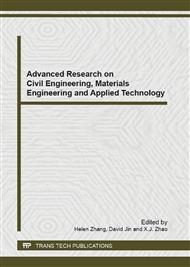[1]
Foster I, Kesselman C, Tuecke S. The Anatomy of the Grid: Enabling Scalable Virtual Organizations, International Journal of Supercom-puter Application and High Performance Computing, vol. 15, No. 3, pp.200-222., (2001).
DOI: 10.1177/109434200101500302
Google Scholar
[2]
Cybok D. A Grid Workflow Infrastructure [A]. Workshop on Grid Workflow[C]. Berlin: GGF-10, (2004).
Google Scholar
[3]
ZHOU Jian-tao, YE Xin-ming, A Review on the Grid Workflow and Its Key Technologies, Journal of Inner Mongolia University, vol. 39, No. 5, 2008, pp.581-589, (in Chinese).
Google Scholar
[4]
Foster I, Kesselman, Nick J, et al. The Physiology of the Grid: An Open Grid Services Architecture for Distributed Systems Integration, [R]. Globus Project, http: /www. globus. org/research /papers /ogsa. pdf.
Google Scholar
[5]
Cardorso J, Miller J, Sheth A, et al. Modeling Quality of Service for Workflow and Web Service Processes, ,Web semantics Journal: Science, Services and Agents on the World Wide Web, vol. 1,No. 3, pp.281-308., (2004).
DOI: 10.1016/j.websem.2004.03.001
Google Scholar
[6]
Parel C, Supekar K, lee Y. A QoS Oriented Framerwork for adaptive Management of Web Service based Workflows, , in proceeding of Database and Expert System 2003 Conference, Springer, 2003, pp.823-835.
DOI: 10.1007/978-3-540-45227-0_80
Google Scholar
[7]
Wang Li, Yuan Yaxing, LongHao, Wang Yong, Design on QoS-based workflow negotiation model in grid environment, JOURNAL OF JIANGSU UNIERSITY(Natural Science Edition), vol. 30, No. 1, 2009, pp.71-74, (in Chinese).
Google Scholar
[8]
Y. Wang, C. Hu, and Z. Du. QoS wared grid workflow schedule, Journal of Software, vol. 17, No. 11, pp.2341-2351. 2006, (in Chinese).
Google Scholar
[9]
LI Jin zhong, LIANG Zheng you. Quality of service estimation research based on the AGWL grid workflow model, Journal of Com-puter Applications, vol. 29, No. 1, pp.323-325, 2009, (in Chinese).
Google Scholar
[10]
Qian Tao, Huiyou Chang, Yang Yi, Chunqin Gu, Yang Yu. QoS Constrained Grid Workflow Scheduling Optimization Based on a Novel PSO Algorithm, in proceeding of 2009 Eighth International Conference on Grid and Cooperative Computing, 2009, pp.153-159.
DOI: 10.1109/gcc.2009.39
Google Scholar
[11]
Askalon. Cloud and Grid Application Development and Computing Environment, http: /www. dps. uibk. ac. at/projects/agwl.
Google Scholar
[12]
Fahringer T., Qin J, Hainzer S. Specification of grid workflow appli-cations with AGWL: An abstract grid workflow language, CCGrid 2005: Proceedings of IEEE International Symposiumon Cluster Com-puting and the Grid, Cardiff UK: IEEE Computer Society Press, (2005).
DOI: 10.1109/ccgrid.2005.1558629
Google Scholar
[13]
J. Kennedy and R. Eberhart, A discrete binary version of the particle swarm algorithm, , Proceedings of the IEEE International Conference on Systems, Man, and Cybernetics, vol. 5, pp.4104-4108, (1997).
DOI: 10.1109/icsmc.1997.637339
Google Scholar
[14]
Q. Pan, M. F. Tasgetiren, and Y. Liang, A discrete particle swarm optimization algorithm for the no wait flowshop scheduling probl-em, Computers & Operations Research, vol. 35, No. 9, 2008, pp.2807-2839.
DOI: 10.1016/j.cor.2006.12.030
Google Scholar
[15]
C. Liao, C. Tseng, and P. Luarn, A discrete version of particle swarm optimization for flowshop scheduling problems, Computers & Operations Research, vol. 34, No. 10, 2007, pp.3099-3111.
DOI: 10.1016/j.cor.2005.11.017
Google Scholar
[16]
M. R. AlRashidi, and M. E. El-Hawary, Hybrid particle swarm opti-mization approach for solving the discrete OPF problem considering the valve loading effects, IEEE Transactions on Power Systems, vol. 22, No. 4, 2007, p.2030-(2038).
DOI: 10.1109/tpwrs.2007.907375
Google Scholar
[17]
J. Wu, J. Zhu, G. Chen, and H. Zhang, Hybrid method for optimal scheduling of short term electric power generation of cascaded hydroelectric plants based on particle swarm optimization and chanceconstrained programming, IEEE Transactions on Power Systems, vol. 23, No. 4, 2008, pp.1570-1579.
DOI: 10.1109/tpwrs.2008.2004822
Google Scholar
[18]
S. NemaA, J. Goulermas, G. Sparrow, and P. Cook, Hybrid particle swarm branch-and-bound (HPB) optimizer for mixed discrete nonlinear programming., IEEE Transactions on Systems, Man, and Cybernetics, Part A: Systems and Humans, vol. 38, No. 6, 2008, pp.1411-1423.
DOI: 10.1109/tsmca.2008.2003536
Google Scholar
[19]
S. L. Ho, S. Yang, G. Ni, E. W. C. Lo, and H. C. Wong, A particle swarm optimization based method for multi objective design optimizations, IEEE Transactions on Magnetics, vol. 41, No. 5, 2005, pp.1756-1759.
DOI: 10.1109/tmag.2005.846033
Google Scholar
[20]
J. S. Heo, K. Y. Lee, and R. Garduno-Ramirez, Multiobjective control of power plant using particle swarm optimization techniques, IEEE Transactions on Energy Conversion, vol. 21, No. 2, 2006, pp.552-561.
DOI: 10.1109/tec.2005.858078
Google Scholar
[21]
D. Liu, K. C. Tan, C. K. Goh, and W. K. Ho, A multi objective memetic algorithm based on particle swarm optimization, IEEE Transactions on Systems, Man and Cybernetics, Part B: Cybernetics, vol. 37, No. 1, 2007, pp.42-50.
DOI: 10.1109/tsmcb.2006.883270
Google Scholar


